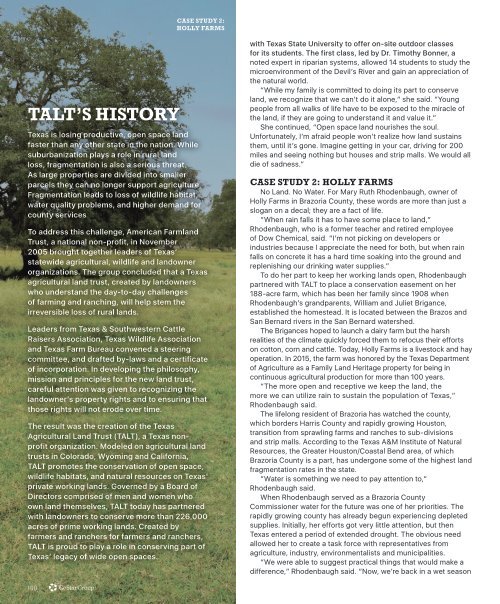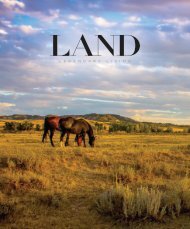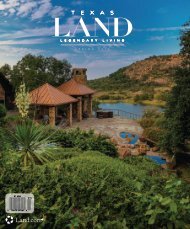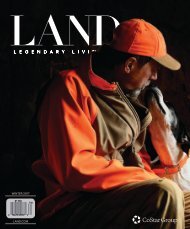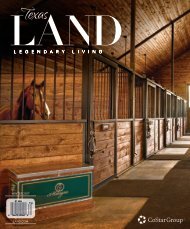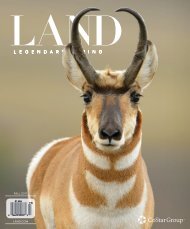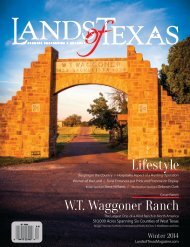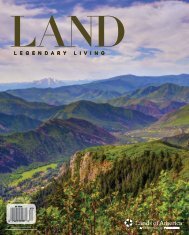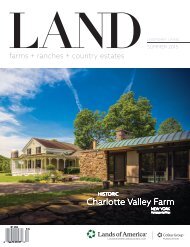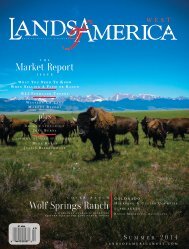Create successful ePaper yourself
Turn your PDF publications into a flip-book with our unique Google optimized e-Paper software.
CASE STUDY 2:<br />
HOLLY FARMS<br />
TALT’S HISTORY<br />
Texas is losing productive, open space land<br />
faster than any other state in the nation. While<br />
suburbanization plays a role in rural land<br />
loss, fragmentation is also a serious threat.<br />
As large properties are divided into smaller<br />
parcels they can no longer support agriculture.<br />
Fragmentation leads to loss of wildlife habitat,<br />
water quality problems, and higher demand for<br />
county services<br />
To address this challenge, American Farmland<br />
Trust, a national non-profit, in November<br />
2005 brought together leaders of Texas’<br />
statewide agricultural, wildlife and landowner<br />
organizations. The group concluded that a Texas<br />
agricultural land trust, created by landowners<br />
who understand the day-to-day challenges<br />
of farming and ranching, will help stem the<br />
irreversible loss of rural lands.<br />
Leaders from Texas & Southwestern Cattle<br />
Raisers Association, Texas Wildlife Association<br />
and Texas Farm Bureau convened a steering<br />
committee, and drafted by-laws and a certificate<br />
of incorporation. In developing the philosophy,<br />
mission and principles for the new land trust,<br />
careful attention was given to recognizing the<br />
landowner’s property rights and to ensuring that<br />
those rights will not erode over time.<br />
The result was the creation of the Texas<br />
Agricultural Land Trust (TALT), a Texas nonprofit<br />
organization. Modeled on agricultural land<br />
trusts in Colorado, Wyoming and California,<br />
TALT promotes the conservation of open space,<br />
wildlife habitats, and natural resources on Texas’<br />
private working lands. Governed by a Board of<br />
Directors comprised of men and women who<br />
own land themselves, TALT today has partnered<br />
with landowners to conserve more than 226,000<br />
acres of prime working lands. Created by<br />
farmers and ranchers for farmers and ranchers,<br />
TALT is proud to play a role in conserving part of<br />
Texas’ legacy of wide open spaces.<br />
with Texas State University to offer on-site outdoor classes<br />
for its students. The first class, led by Dr. Timothy Bonner, a<br />
noted expert in riparian systems, allowed 14 students to study the<br />
microenvironment of the Devil’s River and gain an appreciation of<br />
the natural world.<br />
“While my family is committed to doing its part to conserve<br />
land, we recognize that we can’t do it alone,” she said. “Young<br />
people from all walks of life have to be exposed to the miracle of<br />
the land, if they are going to understand it and value it.”<br />
She continued, “Open space land nourishes the soul.<br />
Unfortunately, I’m afraid people won’t realize how land sustains<br />
them, until it’s gone. Imagine getting in your car, driving for 200<br />
miles and seeing nothing but houses and strip malls. We would all<br />
die of sadness.”<br />
CASE STUDY 2: HOLLY FARMS<br />
No Land. No Water. For Mary Ruth Rhodenbaugh, owner of<br />
Holly Farms in Brazoria County, these words are more than just a<br />
slogan on a decal; they are a fact of life.<br />
“When rain falls it has to have some place to land,”<br />
Rhodenbaugh, who is a former teacher and retired employee<br />
of Dow Chemical, said. “I’m not picking on developers or<br />
industries because I appreciate the need for both, but when rain<br />
falls on concrete it has a hard time soaking into the ground and<br />
replenishing our drinking water supplies.”<br />
To do her part to keep her working lands open, Rhodenbaugh<br />
partnered with TALT to place a conservation easement on her<br />
188-acre farm, which has been her family since 1908 when<br />
Rhodenbaugh’s grandparents, William and Juliet Brigance,<br />
established the homestead. It is located between the Brazos and<br />
San Bernard rivers in the San Bernard watershed.<br />
The Brigances hoped to launch a dairy farm but the harsh<br />
realities of the climate quickly forced them to refocus their efforts<br />
on cotton, corn and cattle. Today, Holly Farms is a livestock and hay<br />
operation. In 2015, the farm was honored by the Texas Department<br />
of Agriculture as a Family Land Heritage property for being in<br />
continuous agricultural production for more than 100 years.<br />
“The more open and receptive we keep the land, the<br />
more we can utilize rain to sustain the population of Texas,”<br />
Rhodenbaugh said.<br />
The lifelong resident of Brazoria has watched the county,<br />
which borders Harris County and rapidly growing Houston,<br />
transition from sprawling farms and ranches to sub-divisions<br />
and strip malls. According to the Texas A&M Institute of Natural<br />
Resources, the Greater Houston/Coastal Bend area, of which<br />
Brazoria County is a part, has undergone some of the highest land<br />
fragmentation rates in the state.<br />
“Water is something we need to pay attention to,”<br />
Rhodenbaugh said.<br />
When Rhodenbaugh served as a Brazoria County<br />
Commissioner water for the future was one of her priorities. The<br />
rapidly growing county has already begun experiencing depleted<br />
supplies. Initially, her efforts got very little attention, but then<br />
Texas entered a period of extended drought. The obvious need<br />
allowed her to create a task force with representatives from<br />
agriculture, industry, environmentalists and municipalities.<br />
“We were able to suggest practical things that would make a<br />
difference,” Rhodenbaugh said. “Now, we’re back in a wet season<br />
100


